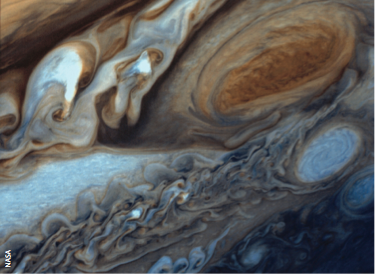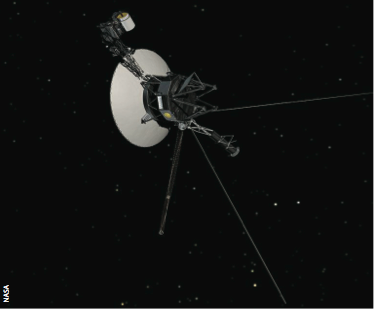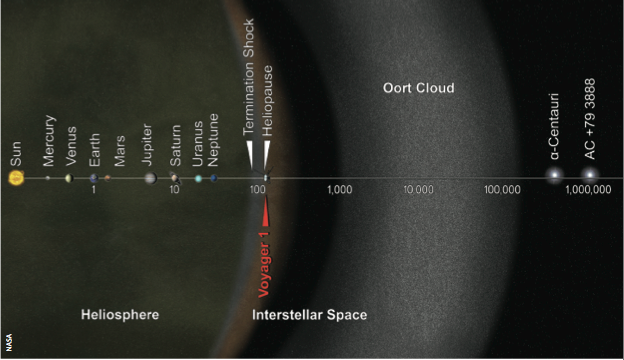SATURDAY, 11 OCTOBER 2014
In 1977, nasa launched two unmanned probes into space to take a ‘Planetary Grand Tour’ of the outer Solar System. Voyager 1 was to explore both the gas giants Jupiter and Saturn, while Voyager 2 would further explore Uranus and Neptune. The timing of the launches was planned to take advantage of a rare alignment of the outer planets that would not occur again for another 175 years. This alignment allowed the probes to exploit the gravitational pull of each planet to alter their trajectory and speed, slingshotting towards the next planet. The probes only needed to carry enough fuel to get to Jupiter, where they received a drastic speed boost which significantly reduced the mission’s costs and flight time. The speed increase was considerable - by slingshotting around Jupiter, the Voyager probes sped up by approximately 35,700 mph. As dictated by the law of momentum conservation, Jupiter slowed in response by about one foot per trillion years.Voyager 1’s flyby of Jupiter provided the first evidence of an extraterrestrial active volcano, with the probes photographing volcanic plumes extending to over 190 miles above the surface of Jupiter’s fourth-largest moon, Io. This geological activity is due to friction from the stretching and squeezing of Io’s crust as it orbits around Jupiter. Voyager 1 was also the first spacecraft to photograph a thin dusty ring surrounding Jupiter, which at the time made Jupiter the third planet with a ring system, after Saturn and Uranus.
Because Voyager 1 had been directed to a close flyby of Titan, Saturn’s largest moon, its trajectory was deflected such that it was now heading out of the orbital plane of the planets, and was unable to continue further planetary exploration. However, its journey was far from over - having completed its primary mission, it was given a second extended mission to explore past the outer planets of the Solar System, beyond the Sun’s protective heliosphere, and out into interstellar space.
Voyager 1 has the accolade of being the most distant man-made object from Earth. As of June 2014, it had travelled over 12 billion miles, making it over three times further away than Neptune, the outermost planet in our Solar System. Despite this vast distance, NASA engineers are still in constant communication with the spacecraft to both receive the measurements it takes, and to provide course corrections and software updates to its onboard computer. At such a distance, each radio signal from Voyager 1 takes over 17 hours to reach Earth and is so weak when it arrives that it requires a worldwide network of giant radio antennae up to 70 metres across as well as orbiting satellites, called the Deep Space Network, to receive it.
Voyager 1 was not the first probe to be sent to outer space–Pioneer 10 and 11 were launched in 1972 and 1973 respectively, and Voyager 2 was launched two weeks earlier than its sister probe. However, because Voyager 1’s flyby of Titan brought it much closer to Saturn than Voyager 2, it gained a greater increase in speed from its slingshot. As a result, Voyager 1 is travelling at around 38,000 mph, compared to around 34,500 mph for Voyager 2, and much faster than the Pioneer probes. So in 1998, despite being launched 5 years later, Voyager 1 overtook Pioneer 10 to become the most distant man-made object - an achievement that will not be surpassed in the foreseeable future.
On 12th September 2013, NASA declared that the Voyager 1 probe had entered interstellar space, 36 years after starting its journey. This was determined from the density of the ionised gas, called plasma, which is present in the space between the stars; within the protective ‘bubble’ of the heliosphere, there is a much lower density of interstellar plasma. As Voyager 1 doesn’t have an active plasma sensor, it had to determine this density indirectly through a massive solar flare in March 2012 that ejected an enormous amount of plasma into the solar system. When this ejection reached Voyager 1 in April 2013, it made the surrounding plasma vibrate. By comparing the pitch of these oscillations to previously- recorded pitches, NASA scientists determined that Voyager 1 was travelling in plasma over 40-times denser than within the outer boundary of the heliosphere. By looking back at previous measurements, they further found that the change in density indicative of passing through the heliopause (the heliosphere’s boundary, where plasma from the Sun’s solar winds meet the stellar winds from surrounding stars) and entering interstellar space occurred back in August 2012. Sound files of these oscillations can be found on NASA’s Voyager website.
Contrary to proclamations in the media, Voyager 1 has not officially left the Solar System. The boundaries of the Solar System are said to extend to where the Sun’s gravity is no longer a dominant force, which is difficult to define. However, the interstellar space beyond the heliosphere is still well within the Sun’s gravitational influence, which is considered to extend all the way out to the vast Oort cloud. This hypothetical cloud of icy matter is thought to be the source of all long-period comets, and lies between 2,000 and 50,000 AU from the Sun. 1 AU is the average distance between the Earth and the Sun (approximately 93 million miles), used by astronomers to measure distances at the scale of the Solar System. Given Voyager 1’s current location and speed, it is not expected to reach the Oort cloud for another 200 years, and not expected to pass through for another 14,000 years!
The Voyager probes only have enough power to last until approximately 2026, so we will unfortunately not get any indication of when they pass into the Oort cloud. However they may still have a grander purpose for humankind; in the absence of air resistance, the probes will continue to drift through the vacuum of space at their current velocity until they either hit an object or are found by an intelligent species. In the vast expanses of space, hitting another object is unlikely, even when passing through the Oort cloud. Therefore, placed aboard the spacecraft are gold-plated audio-visual discs carrying photographs of Earth and its life forms; sounds of whale calls, babies crying, and waves breaking on a shore; music from various cultures and eras; and many mathematical and physical quantities. These Golden Records are humankind’s ‘message in a bottle’, released on the miniscule chance that an intelligent space-faring life-form from another planetary system comes across them, letting them know that they’re not alone in the Universe.
Simon Watson is a post-doctoral researcher at the Wellcome Trust Sanger Institute.





